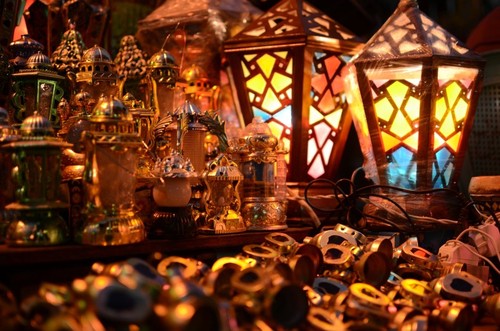 Lanterns, Fanous, are sold in a shop in Khan El-Khalili, a famous bazaar and souk in Cairo, Egypt. (Photo: Halim El-Shaarani/Majalla) Lanterns, Fanous, are sold in a shop in Khan El-Khalili, a famous bazaar and souk in Cairo, Egypt. (Photo: Halim El-Shaarani/Majalla)
|
The word “Fanous” or “Fanoos” in Egyptian dialects is a term originating from Greek. It means lantern, lamp, or light. It was historically used with the meaning of "the light of the world," and is a symbol of hope as in "light in the darkness".
But today it’s commonly known as Fanous Ramadan or simply the Ramadan lantern.
The fanous Ramadan is crafted in a special way to merge Egyptian folklore and Islamic design. Lanterns of all sorts are hung throughout the city – on the streets and decorating cafes, store fronts, and homes.
These lanterns are hung from windows and balconies and on ropes across alleyways. The city glows with them, a sea of colors creating a beautiful and magical atmosphere. It is nearly impossible to find a street in Egypt without a fanous.
In fact, in the weeks leading up to Ramadan, vendors like Ahmed Abu Camel start popping up in the markets and streets of Cairo.
“Workers start manufacturing the fanous twenty days ahead of Ramadan. You see a huge number of fanous spread along the street. It is a huge number,” said Ahmed Abu Camel.
Every year there are fanous with new designs, shapes, and colors. Fanous Ramadan are made from recycled tin cans, plastic, or colored-glass. Whatever they are made of, they play recordings of traditional Ramadan songs.
Copper lanterns with colored-glass may be the most popular symbol of the holy month.
Abeer Antar, an Egyptian lantern artisan, has turned part of her house into a workshop where she makes lanterns from Qullas, traditional unglazed clay water jugs.
She told VOV, “I try to be as creative as possible to make each of my lamps unique. I don't want my customers to go into a shop and see identical items on display. I want to give customers products that have their own identity while retaining traditional features of the Egyptian holy month of Ramadan.”
There are many stories of how this tradition began. One tale says the colorful lanterns evolved from Pharaonic times. Over 5 nights the ancient Egyptians celebrated the birthdays of 5 important deities using torches to light the streets.
Another story says the lantern tradition evolved from Coptic Christians, who used colorful candles at Christmas. Yet another tale says that in the tenth century, children carried lanterns and sang songs as they lit the way for the Fatimid Caliph as he went out in search of the crescent moon that would signal the start of Ramadan.
Whatever the correct story, the fanous symbolizes Ramadan to Muslims and Christians alike. It has passed from generation to generation, and is today explicitly associated with children, and has become a popular custom in Egypt.
Nowadays every house in Egypt has at least one lantern for Ramadan. Grandmother Amal Ahmed says every child wants a new fanous at the start of Ramadan.
“It is a must that I come here every year to buy fanous – one for myself and one for my grandson,” said Amal Ahmed.
Over the past two years, due to the COVID-19 pandemic, the lantern business during Ramadan month significantly decreased. This year, with with epidemic restrictions eased, the business is expected to prosper.
Barakat Safa Zaki of the Cairo Chamber of Commerce said, “For the past two years, sales have fallen due to COVID-19. Because of that, our stock of lanterns has remained stable. This year’s lantern price hasn’t increased and the supply is abundant. Demand is now greater because life has returned to normal.”
In the evenings during Ramadan month, people light up Fanous lanterns. Egyptian children organize lantern processions like the Mid-Autumn Festival in Vietnam.
That is why, before Ramadan, lantern workshops and artisans are extremely busy. Today fanous lights aren’t related to religious events but have become a symbol of joy and fun.